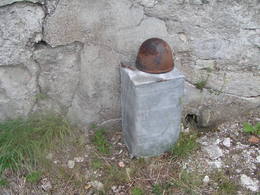Abruka
Prasidėjus karui 1941 m. vasarą, raudoniesiems kareiviams Abrukoje buvo uždrausta bendrauti su vietos gyventojais.
Prasidėjus karui 1941 m. vasarą, Raudonosios armijos kareiviams buvo uždrausta kalbėtis su vietos gyventojais Abrukoje.
Nepaisant to, du kareiviai išslinko iš bazės, kad parsineštų duonos iš kaimo. Jie netyčia užtiko savo komisarą, kuris juos suėmė. Vėliau abu vyrai buvo sušaudyti. Vietiniai gyventojai juos palaidojo Abrukos kapinėse. Greičiausiai jie buvo vieninteliai salos aukos, nes garnizonas be pasipriešinimo pasidavė vokiečiams. Maždaug prieš 10 metų medžiotojai miške rado žmogaus kaukolę rusų šalme. Šalmą jie pasiėmė su savimi, o kaukolę paliko.
Tõnu Veldre pokalbiai su vietos gyventojais 2018–2019 m.
Susijusios vietos
Abrukos 130 mm pakrantės gynybos baterija
Ši pakrantės gynybos baterija yra Pikaninoje, pietinėje Abrukos salos dalyje, 4 km nuo kaimo centro.
3-ioji baterija (29-oji baterija) buvo pastatyta netrukus po Savitarpio pagalbos pakto dekreto, netoli buvusio pasienio posto. Joje tarnavo 125 kareiviai, penki iš jų – karininkai. Būrio vadas buvo vyresnysis leitenantas Savinas, jam talkino komisaras Lukoninas. Iki 1941 m. buvo pastatytos trys 130 mm pabūklų pozicijos. Dvi iš jų buvo sunaikintos per vokiečių aviacijos antskrydžius. Išlikusi pabūklas turėjo būti perkeltas į planuojamą 25a bateriją Lindmetsoje, Servės pusiasalyje, tačiau iš tikrųjų ten pavyko perkelti tik sviedinius ir paraką. Vokiečiai užėmė Abruką 1941 m. spalio 3 d. Estų šauliai susigrąžino salą 1944 m. spalio 9 d. Į salą nedelsiant buvo atgabentas statybos batalionas, kurį sudarė ¾ latvių. Šį kartą buvo pastatytos keturios artilerijos pozicijos, kuriose buvo surinkti amerikiečių 127 mm pabūklai.
Šiandien du iš šių objektų aiškiai matomi iš tolo; kitus du užstoja augmenija. Šalia kelio matyti apaugę apkasai ir įgriuvęs šaudmenų sandėlis su dviem įėjimais, pažymėtas laikina medine lentele. Šiuo metu ši teritorija naudojama kaip pakrantės ganyklos, todėl palei kelią gali būti elektrinės tvoros.





